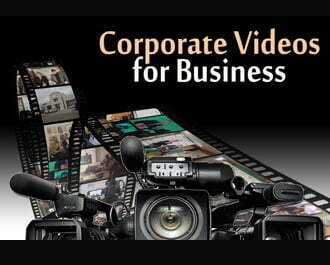Introduction
Most people encounter television on a daily basis. They are used to seeing polished, professional productions made with state of the art technology. Because of this, corporate productions must be as fine tuned and as quality conscious as possible to attract and hold the audience’s interest. Any presentation must entertain as well as inform or it will not be effective.
Fortunately, because of the nature of the video, achieving this kind of quality isn’t as difficult as it may seem. Anyone who watches television has a basic understanding of effective video presentation. Television productions use a wide variety of techniques to maintain audience interest and many of these techniques can be applied to corporate productions as well.
Producing an effective video is a detailed, time-consuming process. It doesn’t have to be difficult, but it does require that everyone involved in the production have a thorough understanding of the audience, the message, and the video production process in general.
Applications
Video can be used to increase sales, aid in training, promote safety and improve corporate communications in general. All of these applications share one common goal: to deliver a message to your audience.
Training
Training videos provide an effective and economical method of presenting the proper procedures for performing specific tasks. This kind of video, when produced creatively, can improve worker performance, increase confidence and encourage thinking as a team.
The most common application for video-based or video-supported training is productions that introduce the background principles to a specific task before a worker starts a new job. This kind of video might explain to salespeople, for example, the principles of effective selling before they start making calls.
Another common application is training videos that demonstrate how to do something step-by-step. Producing a technical presentation like this requires logical, thorough research to be sure that the procedures are demonstrated correctly and are presented in compliance with applicable safety standards and industry regulations. A training video can also be used to provide general information on the background of a subject. For example, a video that explains how a product is manufactured would provide excellent background information for salespeople.
Safety
Video can be an extremely valuable and effective tool to emphasize safety in the workplace and is an integral part of most industrial safety programs. The most effective types of safety videos are those that portray actual accidents or close calls, even if presented humorously. This is the kind of presentation that your audience will be most receptive to because they will identify with the situation. With this type of production, the events must be carefully and safely staged as dramatic reenactments. NEVER put lives in danger by reenacting the actual event.
“ We all know the power of good comedy to capture and hold the attention of an audience, and we also know how long it stays in the memory…What is less well understood is how this great power of comedy works as a teaching instrument…Once you have seen a character on film behave like an idiot, and alarm bell rings in your head next time you are on the verge of making the same mistake yourself.”
In safety videos, “Hollywood” style techniques like frightening music or rapid cuts between an operator’s hand and the blade of a cutting machine can be used to build your audience’s anticipation of what might happen. This technique can frequently be more effective than showing the actual accident. Including statistics and interviews with witnesses or victims of actual accidents can also increase the impact of a video.
Sales
Video can be a powerful sales tool when used creatively. It is a versatile medium and can be applied to a wide variety of promotional applications; anything from desktop presentations to trade show displays. However, in any application, the presentation must be aimed at a specific audience for it to be successful. A sales presentation must also be brief. A five to eight minute tape is long enough to introduce your product or service to a customer. You are dealing with busy people and they aren’t likely to be receptive to a video that is more than eight minutes long. An effective sales video includes basic information about the product or service and emphasizes the key features that make this product or service appealing to the customer. Avoid loading down the presentation with too much technical information. Specifics about a product or service can usually be more accurately presented by using printed material.
Business Communications
Video can also be an effective tool to improve business communications. Interviews, seminars and presentations can be taped, compressed to CD-ROM or DVD, copied and distributed to offices or representatives anywhere in the world, or can be made available online.
Video based employee communications are effective because the audience is accustomed to receiving information in this format – they watch TV. A quarterly company news video that keeps employees informed of company issues and events internationally can have a profound positive impact on morale.
About The Audience
Determining a specific audience is vital to producing an effective video. Who is your audience? What kind of background does your audience have? What kind of presentation would your audience be most receptive to? The answers to questions like these will help you to better understand your audience and to more effectively communicate your message to your audience. To expect one video to work effectively with two or three different types of audiences would be like expecting one textbook to work effectively for both high school freshmen and college seniors.
Understanding the Process
Because of the popularity of home video equipment, many people believe that producing a video is simple; all you need is a camcorder and some blank tapes. Recording an image on videotape is simple (one button), but producing an effective video presentation is not. It requires painstakingly detailed research, planning and scripting before shooting even begins. Listed below are the major steps in video production.
- Determine a need. The subject and application of a potential video production should be researched to determine if the usefulness of the video justifies the expense of production. Will the video be cost effective?
2. Determine the target audience. The target audience must be identified and researched in order for the information in the video to be presented effectively.
3. Prepare and outline. The scriptwriter should research the process or product to be presented and outline the points that should be covered.
4. Hold a pre-production meeting. In this meeting, everyone involved in the production process reviews the outline and gives input to the scriptwriter on how to present the subject on video.
5. Prepare a script. The scriptwriter should consult regularly with the video production personnel to confirm that the scenes contained in the script are technically possible. The scriptwriter should also consult with the end users of the video for input. The people that will be presenting the video to the target audience will have useful insight as to the type of presentation that the audience will be most receptive to.
6. Hold a pre-production meeting. In this meeting, the script is reviewed and any revisions are made.
7. Prepare a storyboard. Storyboards are used to help visualize production and contain a series of illustrations in frames, each with a scene number identifier and a couple of description lines.
8. Hold a pre-production meeting. In this meeting, the storyboard is analyzed for visual ideas, continuity, flow, and basic storyline. Final revisions are made to the script based on the storyboard.
9. Schedule shooting locations. Location shooting should be scheduled for as early as possible because of the possibility of delays due to variables such as weather. Locations should also be scouted in advance to plan staging and to determine any special needs.
10. Gather the necessary visuals. This includes shooting footage and obtaining footage, graphics, and animation from other sources.
11. Hold a post-production meeting. Present at this meeting is the people involved in the production and the people that will give final approval to the finished video. After reviewing the gathered content, final revisions are made to the script, and post production begins.
12. Record the narration.
13. Prepare a final edit.
14. Present the final edit to a test audience. The finished video is presented to a group of people that are unfamiliar with the production for input. This helps predict presentation effectiveness.
15. Hold a post-production meeting. At this meeting the final edit is reviewed and approved or revised by the appropriate people.
The Importance of visuals
Corporate video producers frequently underestimate the importance of visuals in a production. They tend to place primary importance on the words, then attach the visuals; like hanging a cheap painting over a sofa. Some corporate producers even believe that once the narration is written, the script is finished. Nothing could be further from the truth. The video and audio work together in an effective presentation and should never be thought of separately.
The visuals are what hold the audience’s attention to the screen and they play a major role in determining the overall effectiveness of the presentation. Don’t just tell your audience that there is a need for some change, show them. Make the video add to the audio. Ask yourself what should be seen. Show the audience something they can’t get just from sitting in a room. Visuals must be meaningful to maintain viewer interest.
Visuals also need to contain movement; some sort of action that keeps the scene fresh. If a production calls for a shot of a building exterior, include a couple of people walking into the building or have a car drive by – something to break the monotony of a static shot. Be creative. Avoid the trap of giving up on a shot just because it seems too difficult.
“Corporate customs become ingrained and then go unquestioned just because they are corporate customs. This is reflected in the statement, ‘We’ve never done it like that before!’ The proper response to that is ‘Perhaps its time to start. Let’s find out.’ In an era when companies are slimming down, carefully watching returns on expenditures and planning how to handle problems more efficiently, its time to sweep out the door those traditions that restrain progress.”
Writing the Script
The most important step in the video production process is preparing a thorough script. This is when most of the problems with a product can be identified and resolved. Scriptwriting is also the most time-consuming and least glamorous part of video production. However, a thoroughly researched, well planned script is important because it establishes a clear path for the production to follow.
Preparation
Before starting to write, there are several preparation steps that the scriptwriter should take.
1. Consider your audience. Decide on the type of presentation that your audience would be most receptive to: technical, general, or somewhere in between. Identifying your audience is the single most important act of the entire production process.
2. Outline the key points of the topic. Make a list of the most important points to be covered and arrange them in the order they should be presented. As a rule, any presentation should open with a very strong or appealing point because this is when the viewer is most receptive. Close the script with a point that has similar impact because it is the closing moments of a presentation that are most remembered by the viewer.
3. List any points that should not be covered. Depending on your audience and type of presentation, some points may be too technical, unimportant, or may not be complementary to the topic.
4. Watch some television. Select several TV shows that were produced from a script and watch how the camera is used and why. Note the frequency and conditions in which camera movements; such as pans, tilts, and zooms are used. Also, note the number of shots used in the short segment of the broadcast. Usually, there are at least 10 shot changes in any one minute of a film. Remember that your audience is accustomed to and most receptive to this style of production.
Scriptwriting
1. Remember your audience. Present information the way your audience would like to see it. If you don’t capture and keep the viewer’s attention, the production is worthless.
2. Think visually. With each scene ask, “What are we doing here to maintain viewer interest?” Also ask, “How does the visual reinforce the message?”
The 7-second rule. Avoid having static shots in your production that last longer than 7 seconds whenever possible. The viewer will quit watching if he isn’t seeing anything new. Using motion within the frame, or cut to another shot to keep the viewer interested.
4. Avoid slide/tape format. Resist writing in a style that divides the video into one point, one shot. Think more in terms of one sentence, one shot. Use subjects with movement whenever possible.
5. Avoid excessive use of zooms. Zooms are sort of a way to create movement, but zooms can quickly become monotonous and amateurish looking. When watching television, other than news or sporting events, note how seldom zooms are used. Also, psychological studies have shown that people tend to consider information during zooms to be unimportant.
6. Avoid wordy video descriptions. Phrases like, “open with a shot of, cut to” or next we see, “are not necessary. A video description like, “open with a close up of the front sign and zoom out to include the entire building, “could be simplified to, “C.U. (close up) of sign. Zoom out to W.S. (wide shot) of building.”
7. Keep video descriptions parallel to accompanying audio. This makes the script easier to understand and visualize.
8. Consult with others involved in the production. Consulting with the cinematographer and others can also help to improve the “polish” of the production.
9. Keep graphics simple and concise. Graphics with relatively small details become illegible on video. The overuse of graphics also tends to reduce the overall effectiveness of the production and should be avoided.
10. Be brief. The longer a presentation is the more likely losing viewer interest becomes.
Scriptwriting Style
The way information is presented is just as important as the information itself. A great product or idea won’t get very far if your audience isn’t receptive to your style of presentation.
The management communications Coordinator for MG365Studio company, described one of the most common problems with style this way.
“The problem I encounter the most and have to remain aware of in my own writing is the war between the passive and active words. It’s particularly prevalent in corporations, where so many people write in the scientific passive voice or the legalese that supposedly sounds literate and knowledgeable. Tip-offs to passive sentences include such bland openers as ‘There are,’ ‘In order that’ or ‘Following the.’ Bland phrases are throwaway phrases. Instead, nouns are good sentence starters, followed by strong verbs.”1
He described another common problem – vague language. “Be exact. Don’t use he if you mean Robert or the baker. Don’t say many if you mean 500 or 10,000. A clue inexact language is the use of ‘buzzwords.’ Look for the suffix -ize, -ion, -ance, -ate, or -al to find a word that can
be more precise and less bureaucratic. ‘Utilize’ might become use. ‘Practice delegation’ becomes delegate.”
When writing a script, use everyday words. Don’t just tell your audience something, communicate with them. Keep it simple, one idea per sentence. If your script contains a technical term, explain it. Communicate. Let the visuals communicate. Narration may not always be necessary.
Some scriptwriters tend to forget that the narration will be heard, not read, by the audience. According to Carlberg, “Supervisors may deplore the use of fragments. I don’t, if incomplete sentences are used judiciously. We speak in fragments and think in fragments. I view incomplete sentences as snippets of ‘word punctuation’ in a whole thought. They add a natural quality to some print writing and most scripts.”
The visual portion of a script deserves as least as much attention as the audio. Catherine DeVine, a free-lance video writer in North Carolina said, “Some scripts I see have no visuals. It’s up to the director or producer to put something on the screen. That’s not the way it should work. A scriptwriter who writes only audio is probably handling only half the job. If the writer has done the research, then the writer is probably the best person to add the video column to the script.” Some corporate producers even suggest writing the video column first. This forces the script to communicate visually and prevents the writer from relying on the audio to carry the message.
Storyboarding
A storyboard is used to work out the details of a script by drawing each shot or scene on paper. This doesn’t require any artistic ability – use photographs or stick-figures. Number each frame and write a summary below that describes the action and type of shot. A sample storyboard is attached.
Compiling a storyboard, no matter how basic, in advance of shooting is important because it forces you to think about what your audience will see. It also illustrates the visual flow and helps in planning the details of continuity of action.












